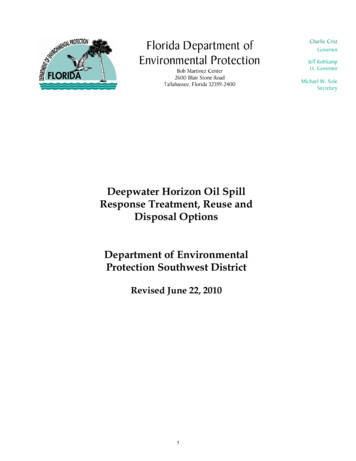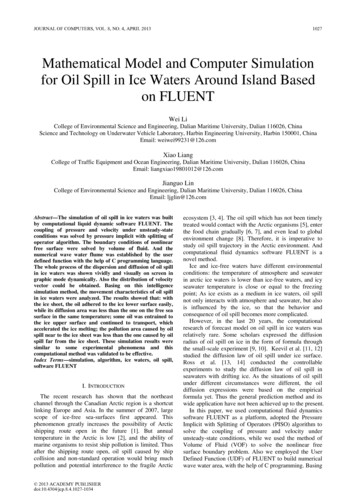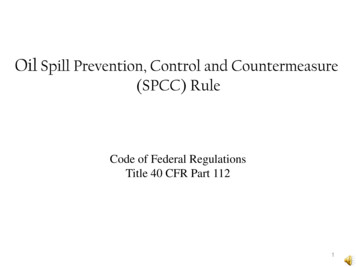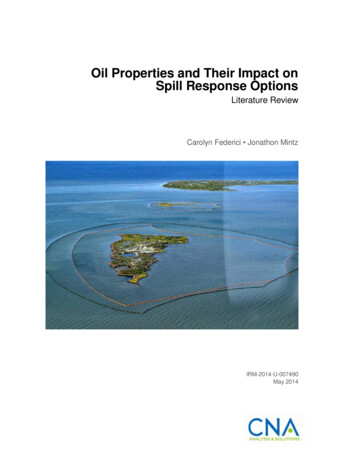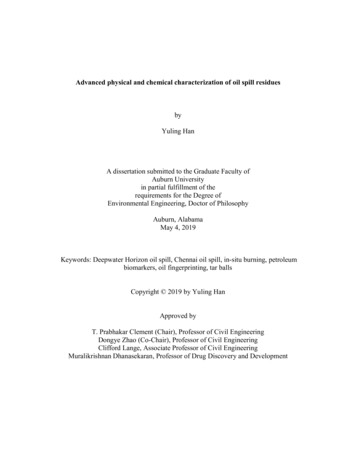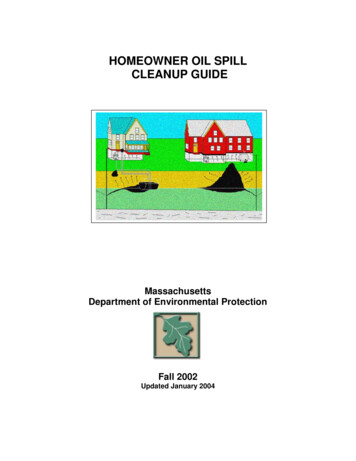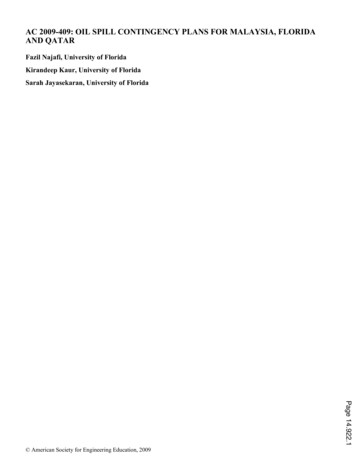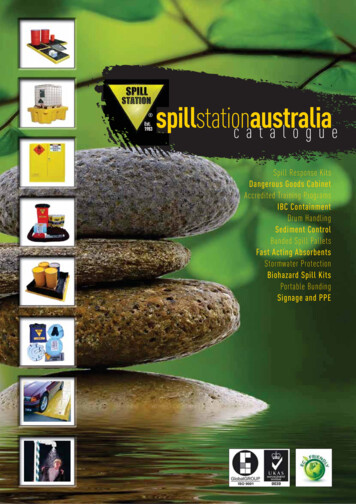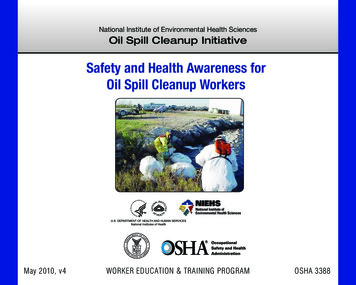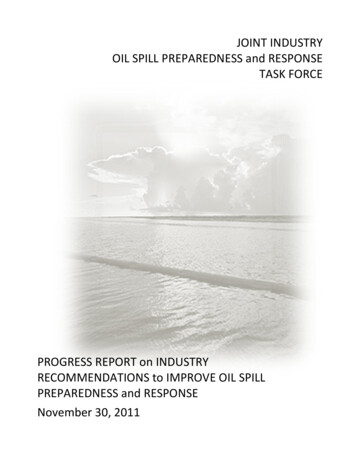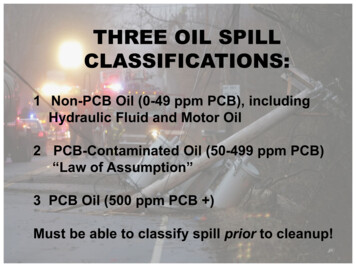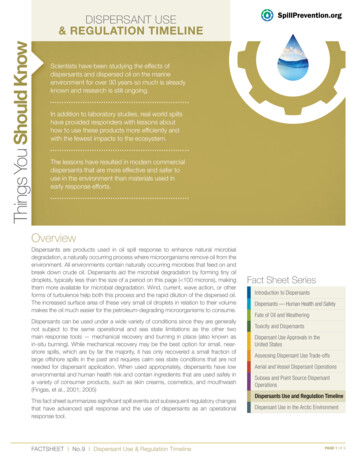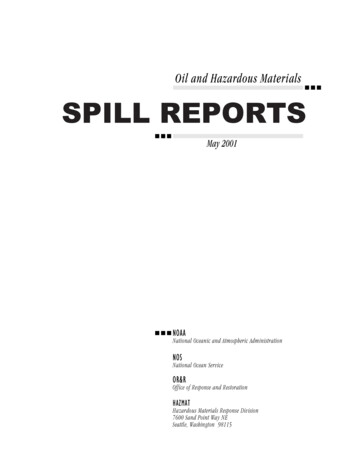
Transcription
Oil and Hazardous MaterialsSPILL REPORTSMay 2001NOAANational Oceanic and Atmospheric AdministrationNOSNational Ocean ServiceOR&ROffice of Response and RestorationHAZMATHazardous Materials Response Division7600 Sand Point Way NESeattle, Washington 98115
ContentsIntroduction.iSpill Report Keys .iiFY99 Spill Responses.ixFY99 Spill Drills and Scenarios. xv1stCoast Guard District.1Boston, Massachusetts5thCoast Guard District .11Middle-Atlantic7thCoast Guard District.25Miami, Florida8thCoast Guard District.37New Orleans, Louisiana9thCoast Guard District.91Cleveland, Ohio11thCoast Guard District.93Alameda, California13thCoast Guard District.111Seattle, Washington17thCoast Guard District.125Anchorage, AlaskaAcronyms . xvii
PLEASE CITE AS:NOAA. 2001. Oil and Hazardous Materials Spill Reports. Seattle:Hazardous Materials Response Division, Office of Response and Restoration,National Oceanic and Atmospheric Administration. 133 pp.
INTRODUCTIONBetween October 1, 1998 and September 30,1999, NOAA’s Officeof Response and Restoration Division’s Scientific Support Coordinators and scientific staff were notified of 71 spill incidents. Theseincidents included potential spills, false alarms, and very minor spillsfor which reports were not prepared (marked with an asterisk in thelist of 1999 spills). Technical and operational assistance provided tothe U.S. Coast Guard for spill incidents in the Nation’s coastal zoneincluded 21 potential oil spills, 34 actual oil spills, 9 chemical spills,2 spills of unknown material, and 5 miscellaneous spills. In additionto the spills listed, NOAA assisted the U.S. Coast Guard with 40simulation exercises.This volume of reports follows the format established for the OilSpill Case Histories Report prepared in 1992 by the Division withU.S. Coast Guard Research and Development Center support so thatmajor spills meeting the criteria for inclusion may be incorporatedeasily into updated case histories reports.Each report in this volume is organized as follows: A list of headers that summarizes the spill name; location;product; size; use of dispersants, bioremediation, and in-situburning; other special interests; shoreline types affected; andkeywords. A brief incident summary including weather conditions anddescription of the overall spill response. A description of the behavior of the spilled material includingmovement, evaporation, mousse formation, and dispersion. A discussion of countermeasures and mitigation. A description of other special interest issues such as communication problems, unusual hazards encountered, and largelosses of organisms. A list of references that document the response operations.Although the master list on the following pages includes all of theincidents for which the Division provided support, only those incidents where the pollutant actually entered the environment arereported on in this volume. These reports are abbreviated and aremeant to serve only as a summary of the Division’s response torequests from Federal On-Scene Coordinators for each of the events.Additional details on any of the responses may be obtained from theappropriate Scientific Support Coordinator or U.S. Coast Guardoffice.i
Spill Report KeysName of Spill:NOAA SSC:Date of Spill (mmddyy):Location of Spill: text descriptionLatitude: degrees, minutes, N or SLongitude: degrees, minutes, E or WSpilled Material: specific productSpilled Material Type:Type 1 - Very Light Oils (jet fuels, gasoline)Type 2 - Light Oils (diesel, No. 2 fuel oil, light crudes)Type 3 - Medium Oils (most crude oils)Type 4 - Heavy Oils (heavy crude oils, No. 6 fuel oil, bunker c)Type 5 - Hazardous materialAmount: (Barrels, gallons, or weight in pounds if hazardousmaterial)::Source of Spill: tank vessel, non-tank vessel, barge, facility, pipeline,platformResources at Risk: See ADispersants: Yes or NoBioremediation: Yes or NoIn-situ Burning: Yes or NoOther Special Interest:Destruction of marshes, mangroves, or tidal flatsExtraordinarily successful salvage operationsMassive habitat lossMassive wildlife impactOil/ice interactions and adverse weather conditionsUnusual, experimental, or innovative cleanup techniquesShoreline Types Impacted: See Bii
Keywords: See CIncident Summary:Date and time of incidentLocation of incidentWeather at time of incidentSummary of eventsActions of responsible party and response organizationsLevel of federal involvementDuration of responseBehavior of Spilled Material:Formation of slicks, sheen, or mousseMovement on the water of spilled materialMovement in the air of spilled materialAreas impactedAmount spilled; amount recovered(land, sea, contaminated debris)Amount not recovered(sinking, evaporation, weathering, dissolution)Countermeasures and Mitigation:Control at incident siteOffloading and lightering operations; movement of vesselPrecautionary protection of sensitive areasOpen water recoveryShoreline cleanupRemoval and disposal of spilled material orcontaminated debrisOther Special Interest Issues: See DNOAA Activities:Involvement in response (on-scene, by phone and fax)Support providedParticipation in committees and special projectsUnusual responsibilitiesMeetings attended/recommendations madeDuration of NOAA supportReferences:iii
Spill Report KeysAResources at RiskHabitats(See shoreline types key below), eelgrass beds, submerged aquaticvegetation (SAV), kelp, coral reefs, worm bedsMarine MammalsWhales, dolphins, sea lions, seals, sea otters, manatees, walruses, polarbears, population concentration areas, haulouts, migration routes,seasonal use areasTerrestrial MammalsMustelids, rodents, deer, bears, population concentration areas, intertidal feeding areasBirdsDiving coastal birds, waterfowl, alcids, petrels, fulmars, shorebirds,wading birds, gulls, terns, raptors, rookeries, foraging areas, winteringareas, migration stopover areas, wintering concentration areas, nestingbeaches, migratory routes, critical forage areasFishAnadromous fish, beach spawners, kelp spawners, nursery areas, reeffish (includes fish using hard-bottom habitats), spawning streams,spawning beaches, estuarine fish, demersal fishMollusksOysters, mussels, clams, scallops, abalone, conchs, whelk, squid,octopuses, seed beds, leased beds, abundant beds, harvest areas, highconcentration sitesCrustaceansShrimp, crab, lobster, nursery areas, high concentration sitesReptilesSea turtles, alligators, nesting beaches, concentration areasRecreationBeaches, marinas, boat ramps, diving areas, high-use recreationalboating areas, high-use recreational fishing areas, State ParksManagement AreasMarine Sanctuaries, National Parks, Refuges, Wildlife Preserves,Reservesiv
Resource ExtractionSubsistence, officially designated harvest sites, commercial fisheries,power plant water intakes, drinking water intakes, industrial waterintakes, intertidal and subtidal mining leases, fish/shrimp/bivalve/plantaquaculture sites, log storage areasCulturalArchaeological sites, Native American LandsBShoreline Types Impactedbrackish marshescoarse gravel beachescoarse sand beachescoastal structuresconsolidated seawallsconsolidated shorescypress swampsdeveloped uplanderoding bluffsexposed bedrock bluffsexposed bluffsexposed fine sand beachesexposed riprapexposed rocky platformsexposed rocky shoresexposed scarpsexposed seawallsexposed tidal flatsexposed tidal flats (low biomass)exposed tidal flats (moderate biomass)exposed unconsolidated sediment bluffsextensive intertidal marshesextensive salt marshesextensive wetlandsfine sand beachesflatsfreshwater flatfreshwater marshesfreshwater swampsfringing salt marshesfringing wetlandshardwood swampsleveeslow banksmangrovesmarshesmixed sand and shell beachesv
mixed sediment beachespiersriprapsalt marshsaltwater marshessand/gravel beachesshell beachessheltered bedrock bluffssheltered fine-grained sand beachessheltered impermeable bankssheltered mangrovessheltered marshessheltered rocky shoressheltered seawallssheltered tidal flatsshelving bedrock shoresspoil banksupratidal marshesswamptidal mudflatunforested uplandunvegetated steep banks and cliffsvegetated bluffsvegetated low banksvegetated riverbankvertical rocky shoreswavecut platformsCKey wordsAbandoned Barge Actair-activated pumpsARTESbioremediationCenters for Disease ControlClean Bay Inc.containment boomCorexit 9527DBRCdispersantendangered speciesevaporationexposed rocky shoresfilter fencesFood and Drug Administrationgroundtruthhigh-pressure, warm-water washinghydro-blastingvi
in-situ burningInternational Bird Rescue and Research CenterInternational Tanker Owners Pollution Federation (ITOPF)low-pressure washingNAVSUPSALVNOAA National Marine Fisheries Service LaboratoryPacific flywaypotential spillpropane cannonsremote sensingreoilingRIDS (Response Information Data Sheets)salvageseafood harvesting banshallow water recoverysiphon damsskimmersSLAR (side-looking airborne radar)smotheringsorbent boomsorbent pompomsstarshell-type devicetourism lossesvacuum trucksvolunteersweed cuttersweir/pump skimmerDOther Special Interest IssuesEffects to tourism, recreation areas, or personal propertyClosure of commercial or recreational fishing areas and public landsClosure of shipping lanes and vehicle traffic routesWildlife impacts and rehabilitationEcological destruction and habitat loss due to spilled material impactsEcological destruction and habitat loss due to cleanup operationsEffects to human health and safetyBioremediation, dispersant, in-situ burning operationsUnusual, experimental, or innovative cleanup techniquesComplex successful salvage operationsLogistical or operational problems(including adverse weather conditions)Interaction with foreign or Native authoritiesMedia interestVolunteer response and organizationStudies conducted; ongoing researchvii
FY 99 SpillsOctober 1, 1998-—September 30, 1999Date ofIncidentNo.Report Name/Hotline 01 Oct 981BP Pipeline Spill/335Gulf of Mexicolight crude83 on-scene07 Oct 982Mystery Spill/336Monterey Bay, CAunknown111 on-scene16 Oct 983F/V Paradise Queen II/337Kure Atolldiesel14phone/fax30 Oct 984T/V Champion Trader/338Southwest Pass, LAIFO 38082 on-scene05 Nov 985F/V Miss Conch/339Matagordadiesel8phone/fax06 Nov 986train derailment/340Huntington, WVchemicals5phone10 Nov 987F/V Joyce/341*Freeport, TXdiesel8phone/fax13 Nov 988C/V Atoll Atlantic/342New Haven, CTAcrolein1phone/fax19 Nov 989Lykes Liberator/343*Houston, TXchemicals8phone/fax19 Nov 9810Sea Barge Trader/344*Florida to Puerto Ricohazardousmaterials7phone/fax24 Nov 9811T/V Somerset/345Gulf of MexicoArabian crude8phone/fax11 Dec 9812M/V Haida Monarch/346Gulf of Alaskalogs17phone/fax15 Dec 9813T/B CTCO 2601/347Tampa Bay, FLlube oil7phone/fax16 Dec 9814Monarch Seas RCL/348St. Martindiesel7phone/fax23 Dec 9815F/V Captain Justin/349Tampa Bay, FLdiesel7phone/fax
FY99 Spill ReportDate ofIncidentNo.28 Dec 9816M/V Violetta/350Galveston, TXbunker, diesel,lube oil8phone/fax29 Dec 9817Train Derailment/351Wittenburg, MOtitaniumdioxide91 on-scene11 Jan 9918tug Miss Jessica/352Galveston, TXdiesel8phone/fax13 Jan 9919T/B M&M 100/353Port Forchon, LAdiesel8phone/fax21 Jan 9920T/B 2125/354*Chocolate Bayou, TXxylene8phone/fax22 Jan 9921Mystery Spill/355NC/SC coastsunknown oil5phone/fax28 Jan 9922Mystery Tarballs/356San Juan , PRtarballs7phone/fax02 Feb 9923E Cameron Block*Gulf of Mexicocrude oil8phone04 Feb 9924M/V New Carissa/357Coos Bay, OR#2 fuel oil139 on-scene05 Feb 9925Enighed Pond/358San Juan, PRdiesel7phone/fax09 Feb 9926Rig High IslandPlatform 139A/359off shore LAcrude oil8phone/fax09 Feb 9927East Cameron Block 272/360off shore LAunknown8phone/fax10 Feb 9928Tennessee River/361Knoxville, TNdiesel93 on-scene12 Feb 9929Dredge Louisiana/362Corpus Christie Bay, TXdiesel8phone/fax15 Feb 9930Seaspan Rigger/363Cape Spencer, AKlogs17phone17 Feb 9931Abandoned Facility/364Morgan City, LAcrude oil8phonexReport Name/Hotline NumberCommodityInvolvedUSCGDistrictNOAAInvolvement
FY99 Spill ReportDate ofIncidentNo.Report Name/Hotline 18 Feb 9932F/V Sea Quayle*Whale Passage, AKdiesel17phone19 Feb 9933M/V Hekifu*Dutch Harbor, AKmisc. oils17 phone/fax22 Feb 9934Ocean Winner/365*Galveston, TXred diesel8phone27 Feb 9935T/V Hyde Park/366New Orleans, LApurolysis gasBunker C84 on-scene04 Mar 9936M/V HollandicConfidenc/367Cape Mendicino, CAsulfurIFOmarine-gradefuel oil11phone/fax17 Mar 9937Thermal Release Item/368St. Lawrence River, NYTherminol 551phone/fax23 Mar 9938Kuehne Chemical/369*Kearny, NJ (potential)sodium hydroxide 1sodium hydrochloritephone/fax1 Apr39fishing boat aground/370Pillar Point, CAdiesel111 on-scene5 Apr40M/V Algontario/371St Mary's River, MIIFO, #2, cement91 on-scene9 Apr41Oil Rig East Cameron 60/372*Cameron, LAnatural gascondensate8phone/fax15 Apr 9942F/V Poseiden/373Panama, FLdeath of crewinvestigation81 on-scene19 Apr 9943T/V Sea World/374Galveston, TXBasrah crude oil8phone/fax08 May 9944F/V Controller Bay*Cave Point, AKmisc. oils17phone/fax10 May 9945F/V Ying Fa*Adak, AKanhydrousammonia17phone10 May 9946M/V Redfin*Cold Bay, AKdiesel, lube17phone/faxxi
FY99 Spill ReportDate ofIncidentNo.13 May 9947Rosarito Beach pipeline/375Rosarito Beach, Mexico#6 fuel oil112 on-scene06 Jun 9948Oil slick/376*central California coastunknown11phone/fax09 Jun 9949Tug Harvey Challenger/377Galveston Bay, TXpropane82 on-scene12 Jun 9950M/V Wilderness Adventure/378 dieselGlacier Bay, AK17phone/fax14 Jun 9951Northeast Florida Tarballs/379 tarballsNE FL7phone/fax25 Jun 9952Rig Falcon 17/380Amelia, LAnatural gasdiesel, drilling mud82 on-scene27 Jun 9953T/V Arco Texas/381Ferndale, WANorth Slope Crude13phone/fax01 Jul 9954F/V Su-CeK*Sitka Sound, AKdiesel17phone/fax02 Jul 9955O'Neal Tank Battery/382*Golden Meadows, LAcrude oil81 on-scene10 Jul 9956Chemical Spill/383Red RiverShreveport, LA2-ethylhexanol82 on-scene16 Jul 9957F/V Sea Farer*New Bedford, MAdiesel1phone/fax20 Jul 9958Mystery Spill/384Florence, ORtarballs111 on-scene21 Jul 9959M/V Navios Pioneer/385Port Royal, SCcrushed granite5phone/fax23 Jul 9960Shell Oil Pipeline/386Gulf of Mexico30 miles SSE ofAtchafalaya, LAlight condensate81 on-scene27 Jul 9961M/V Spirit of 98/387Tracy ArmSoutheast Alaskadiesel fuel17phone/faxxiiReport Name/Hotline NumberCommodityInvolvedUSCGDistrictNOAAInvolvement
FY99 Spill ReportDate ofIncidentNo.Report Name/Hotline 30 Jul 9962pipeline break/388Ramah, LAcrude oil81 on-scene9 Aug 9963Barge collision/389Mt. Vernon, INgasoline91 on-scene12 Aug 9964M/V Gardenia Ace/390Pt. Piedras Blancas, CAmarine diesel17 Aug 9965T/B Florida*Cape Cod Canal27 Aug 996629 Aug 9911phone/fax#6 fuel oil1phonefreighter Blue Master/391Galveston, TXIFO 1808phone/fax67Mystery Spill/392*Delawareunknown oil1phone/fax08 Sep 9968Dredge Stuyvesant/393Humbolt Bay, CAIFO-180113 on-scene14 Sep 9969F/V Gussie Flynn/394Mississippi Sound, MSdieselammoniaPropane8phone/fax22 Sep 9970Mississippi River/395water intake/395New Orleans, LAethylene dichloride(EDC)81 on-scenexiii
FY99 Spill ReportFY99 Drills and ScenariosOctober 1, 1998—September 30, 10/22/9810/20/9811/10/98PlanningDrillNavy DrillIndustry PrepPlanningCon/Ed DrillMSO PortlandIndustry PrepWorkshop ScenWorkshop ScenStrait of Juan Fuca, WAUpper Cook Inlet, AKNew Haven CTOhio RiverN. San Juan Islands,WAAnchorage, AKLA/Long Beach, CAAdmiralty Inlet, WABurns Harbor, IndianaBeaufort, AKEast River, NYWillamette River, ORFort Lauderdale, FLBoston Harbor, MABuzzards Bay, t planWorkshop ScenCANUSLANTUSCG WorkshopUSCG WorkshopSTOCS ScenarioSCAT WorkshopTX Disp Workshop.CA Disp WorkshopCA Disp WorkshopGulf Strike TeamPREP DrillLynn CanalSt. ThomasEastport, MEGalveston Bay, TXSan Francisco Bay, CADelaware Bay, DESt. Lawrence RiverGalveston Bay, TXSan Francisco Bight, CASan Francisco Bay, CA20 miles off TimbBuzzard’s Bay, MATATTATTATOSSMOSSMTATTATDisp. TablesDisp TableDisp TableUnann /20/995/25/995/26/996/29.99USCG DrillCISPRIMiddle East DrillMSO San FranciscoMSO San FranciscoCANUSDIXMSO HonoluluBeaufort, SCUpper Cook Inlet, AKGaza StripMoss LandingCresent CityDixon EntranceHonolulu 9/998/19/999/3/999/23/99xv
FY99 Spill Reportxvi
U.S. Coast Guard District 1Atlantic Atoll1T/V Nord/Jahre Traveler3Mystery Sheen5Kuehne Chemical Company7F/V Sea Farer9
Name of Spill:NOAA SSC:USCG District:Date of Spill:Location of Spill:Latitude:Longitude:Spilled Material:Spilled Material Type:Amount:Source of Spill:Resources at Risk:Dispersants:Bioremediation:In-situ Burning:Other Special Interest:Shoreline Types Impacted:Keywords:C/V Atlantic AtollEd Levine111/13/98New Haven, Connecticut41 18.2' N72 54.2' Wacrolein5undeterminedcontainer vesselhuman health and safetyNNNnonenonenoneIncident Summary:On November 13, 1998, the container vessel (C/V) Atlantic Atoll was docked at the terminalin New Haven Harbor when two longshoremen unloading the vessel began showingsymptoms of acrolein exposure (one of the cargoes on the vessel) and were hospitalized. A'Level A' inspection into the hold was conducted and readings ranged from 0.01 to 0.05parts per million (ppm) near the five acrolein marine portable containers (from 4000 to 4500gallons each) and 0.5 ppm under the containers. The immediately dangerous to life andhealth (IDLH) level was 2 ppm. Other cargoes onboard were zinc ingots and uranium.Personnel from the State of Connecticut’s Department of Health and Department ofEnvironmental Protection and the New Haven Fire Department were on-scene. Also onscene was a mobile laboratory with a gas chromatography-mass spectrometry (GC-MS,).The vessel was secured for the night with hatches open to help ventilate the hold. TheUnited States Coast Guard (USCG) was waiting for an owner's representative who wasfamiliar with acrolein before proceeding.November 12, the responsible party's (RP) representative arrived with contractors fromBoots & Coots. Additional entries into the hold were made that morning and levels werevery low. The testing results from the day before were in question as to possible samplecontamination.Behavior of Spilled Material:Hazards associated with acrolein are hazardous atmospheres from the gaseous vapors andvery low lower explosion limit (LEL) of 2.8 percent. Acrolein gas is heavier than air and willflow along the deck and sink to the lowest level. Acrolein liquid is less dense than water andwill float.Countermeasures and Mitigation:A plan was devised to remove the five acrolein marine portable containers from belowdecks, inspect them, make any needed repairs, and store them back on the ship above deck.NOAA Activities:
The USCG Marine Safety Office (MSO) New Haven notified NOAA of this incident onNovember 11, 1998. The SSC researched the chemical and its properties and made2suggestions concerning flammability and the use of CO to reduce the chance of combustionas well as ventilating the hold. Also, ALOHA plume models were run with worst case andvarious other scenarios. NOAA was involved in this incident for several hours viatelephone.References:NOAA. 1992c. The ALOHA 5.1 Manual for the Apple Macintosh and IBM Compatibles.Washington, D.C.: National Safety Council. 350 pp.NOAA. 1993. The CAMEO 4.0 Manual. Washington, D.C.: National Safety Council. 440pp.
Name of Spill:NOAA SSC:USCG District:Date of Spill:Location of Spill:Latitude:Longitude:Spilled Material:Spilled Material Type:Amount:Source of Spill:Resources at Risk:Dispersants:Bioremediation:In-situ Burning:Other Special Interest:Shoreline Types Impacted:Keywords:T/V Nord-Jahre TravelerEd Levine112/19/98Long Island, New York071 59' W40 19.7' Ncrude oil31 gallontankernoneNNNnonenonenoneIncident Summary:At approximately 1300 on December 19, 1998, the USCG Marine Safety Detachment (MSD)Coram, New York received notification of a one-liter spill from the T/V Nord-Jahre Traveler. Thespill occurred from a fitting during an off-shore lightering operation. The USCG MSO Long IslandSound (LIS) requested an overflight, but was unable to obtain an aircraft.NOAA Activities:NOAA was notified at 2000, December 19, 1998, by MSO LIS. An overflight was scheduled forthe morning of December 20 and MSO requested a trajectory to identify positions for the aircraftto search in case the spill was larger than initially reported. The SSC reported the position tosearch would be a 6-mile radius around the point 40 24' N / 72 05' W.The overflight found no oil.Reference:Torgrimson, Gary M. 1984. The On-Scene Spill Model: A User's Guide. NOAA TechnicalMemorandum NOAA OMA-12. Seattle: Office of Oceanography and Marine Assessment. 87pp. (OSSM reference)
Name of Spill:NOAA SSC:USCG District:Date of Spill:Location of Spill:Latitude:Longitude:Spilled Material:Spilled Material Type:Amount:Source of Spill:Resources at Risk:Dispersants:Bioremediation:In-situ Burning:Other Special Interest:Shoreline Types Impacted:Keywords:Mystery SheenEd Levine12/11/99Long Island, New York72 45' W40 33' cident Summary:At about 1630, February 11, 1999, a private airplane pilot reported to USCG MSO LIS. Asheen in the Moriches Inlet. The sheen was approximately 1000 feet long about 20 milessouth of Long Island, New York.Weather at the time was winds from the south at 10 to 20 knots, seas 5 feet. The sheen wasexpected to move about 2.5 miles north of its reported position. The MSO had planned ahelicopter search of the area with an infrared camera; however, there were no helicoptersavailable.NOAA Activities:On February 11, 1999, NOAA was notified of this incident by MSO LIS who requestedtrajectory information.NOAA reported that the oil would most likely dissipate by daybreak. However, if it were aheavier oil it may make landfall between Shinnecock and Moriches. The MSO sent a beachsurvey team to check, but no tarballs were spotted.References:Torgrimson, Gary M. 1984. The On-Scene Spill Model: A User's Guide. NOAA TechnicalMemorandum NOAA OMA-12. Seattle: Office of Oceanography and Marine Assessment.87 pp. (OSSM reference)
Name of Spill:NOAA SSC:USCG District:Date of Spill:Location of Spill:Latitude:Longitude:Spilled Material:Spilled Material Type:Amount:Source of Spill:Resources at Risk:Dispersants:Bioremediation:In-situ Burning:Other Special Interest:Shoreline Types Impacted:Keywords:Kuehne Chemicals CompanyEd Levine103/25/99Kearny, New Jersey40 44.0' N074 06.1' Wsodium hydroxide, sodium hypochlorite530,000 gallonsstorage tankFish: estuarine fishResource Extraction: power plant water intakes, industrial waterintakesNNNnoneriprap, spoil bank, mixed sediment beachesnoneIncident Summary:On the morning of March 23, 1999, the USCG Activities New York (ACTNY) was notified of achemical tank collapse at the Kuehne Chemical facility in Kearny, New Jersey. The tank containedapproximately 30,000 gallons of sodium hydroxide (50% solution). In the process of collapsing, thetank had broken an adjoining pipe containing sodium hypochlorite (50% solution) spilling a smallamount of liquid. The sodium hydroxide was mostly contained within the dike around the tank, but1,000 gallons escaped and entered the Hackensack River.The State Department of Environmental Protection and USCG personnel were on-scene and monitoringthe situation. They planned to neutralize the sodium hydroxide, then collect and remove it.This response lasted for several days.NOAA Activities:NOAA was notified of this incident March 25, 1999, by USCG ACTNY who requestedinformation about the chemicals involved. After consulting a chemist from Louisiana StateUniversity and the Chemical Reactivity Worksheet, the SSC reported that the chemicals wouldnot react with each other. The main concern was skin contact with the sodium hydroxidebecause it is a strong base that can dissolve skin. The pH of the sodium hydroxide was 14. Itwas calculated that to lower the pH to background (about 7.5 to 8) from the 1,000 gallonsspilled into the river would require about one billion gallons of water (about 2 river miles). Theslug would travel with the tides (initially flooding at 0.8 knots). A localized fish kill wasanticipated.NOAA supported this incident by phone and fax for 2 hoursReferencesNOAA Hotline 369, 2 Reports
Name of Spill:Date of Spill:SSC:Location of Spill:Latitude:Longitude:Spilled Material:Spilled Material Type:Amount:Source of Spill:Resources at Risk:Dispersants:Bioremediation:In-Situ Burning:Other Special Interest:Shoreline Types Impacted:Keywords:F/V Sea Farer7/16/99Stephen LehmannNew Bedford Harbor, Massachussets41 38.23 N070 55.2 Wdiesel25000 gallonsfishing vesselsalt marsh, tidal flatsNNNnonesand beachboom, sorbentIncident Summary:The fishing vessel Sea Farer sank at Eathan Fishing Dock, New Bedford, Massachusettsin the early hours of July 16, 1999. She carried an estimated 6000 gallons of diesel fuel.The owners contracted with divers to plug the vents and secure the source. Theimmediate area was boomed.On-scene USCG personnel estimated 500 gallons of fuel in the water around the pier.By mid morning, it was suspected that the vent plugs had come free and that more oilwas coming from the vessel.NOAA Activities:NOAA SSC was contacted and resources at risk and oil fate and trajectory estimateswere requested and provided.Minor impacts were seen on Fairhaven Beach. Contractors were dispatched to recoverand clean oil at the beach. Vents were recapped.On July 23 the vessel was refloated and 5000 gallons were recovered. The vessel wastowed to a local shipyard for repair.References:NOAA. 1993. ADIOS (Automated Data Inquiry for Oil Spills) User's Manual. Seattle: HazardousMaterials Response and Assessment Division, NOAA. 50 pp.NOAA. 1994. Shio. Tide computer program (prototype). Seattle: Hazardous Materials Response andAssessment Division, NOAA.
Research Planning Institute. 1980. Sensitivity of coastal environments and wildlife to spilled oil:Massachusetts. An atlas of coastal resources. Seattle: Ocean Assessments Division, NOAA. 49 maps.
U.S. Coast Guard District 5Train Derailment11M/V Star Evviva13C/V Independent Spirit15M/V Navios Pioneer17Mercury Contaminated Wastewater19C/V Humacao21T/B Bay Trader23
Name of Spill:Date of Spill:USCG District:SSC:Location of Spill:Spilled Material:Spilled Material Type:Amount:Source of Spill:Resources at Risk:Dispersants:Bioremediation:In-Situ Burning:Other Special Interest:Shoreline Types Impacted:Keywords:Train Derailment11/05/985Stephen LehmannHuntington, West Virginiaconcentrated hydrochloric acid, carbon disulphide,propelene oxide, isopropinal, ethynal, and ammoniahydroxide5N/Aderailed trainpublic safetyNNNnonenoneIncident Summary:A train traveling along the Ohio River in Huntington, West Virginia had six cars derail; fivewere not loaded but had residue of various chemicals, including carbon disulphide (aflammable liquid), concentrated HCl (an acid), and ammonia hydroxide (a poison). The onlycar carrying cargo was the HCl car.Responders on-scene determined that the HCl car was leaking and the USCG closed the riverfor a distance of 2 miles. Residents, within 2 miles, were notified and warned to stay indoors(shelter in place) by the Huntington Fire Department. HAZMAT teams from CSX (the railroad)and Dupont Chemical were called on- scene. CSX and Dupont made level B entriesNOAA Activities:.NOAA was notified of this incident on November 5, 1998, by the USCG who requested offscene support. NOAA provided information as to the potential reactions of the mixture ofchemicals and assistance with the ALOHA air dispersion model. The mixture of the ammoniaand the acid was considered the greatest concern, other than fire and direct exposure from purechemicals. For planning purposes it was assumed that each of the “empty” tank cars held 600gallons of product.The HCl was thought to be at a concentration no greater that 38%. Given that the chemical wasleaking into soil that is heavy with limestone, it was recommended that the HCl be allowed toleak and react slowly with the soil, reducing the threat.References:GATX Train Car Manual
NOAA Hotline 340, 1 ReportNOAA. 1993. The CAMEO 4.0 Manual. Washington, D.C.: Nat
the U.S. Coast Guard for spill incidents in the Nation's coastal zone included 21 potential oil spills, 34 actual oil spills, 9 chemical spills, 2 spills of unknown material, and 5 miscellaneous spills. In addition to the spills listed, NOAA assisted the U.S. Coast Guard with 40 simulation exercises.
